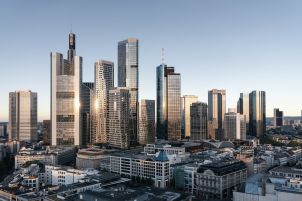New turnover record in office markets: Take-up of almost 1.76 million square metres in first six months of 2016
In the first half of 2016, take-up of office premises in the eight most important German locations – Berlin, Cologne, Düsseldorf, Essen, Frankfurt, Hamburg, Leipzig and Munich – totalled just under 1.76 million m², 13 percent above the already very good prior-year figure.
"As expected, the upward trend in office markets already apparent in the early months of the year continued in the second quarter. At 1.76 million m², take-up represented a new record for any first half, exceeding the previous top mark of 2008. The result was 13 % up on the prior-year total and surpassed the ten-year average by a handsome 18 %", says Marcus Zorn, Deputy CEO of BNP Paribas Real Estate Germany.
The inter-city ranking is headed by Berlin, which achieved its best performance ever, with 405,000 m² (+21 %). In second place, as was to be expected, comes Munich, with 373,000 m² (+21.5 %). For Bavaria's capital city that represents the second-best result ever registered. Completing the leading trio is Hamburg. But with 233,000 m², it is the only really large German city to suffer a slight drop in turnover (-9 %).
The above-average take-up figures of the past two years combined with the still moderate extent of construction activity are reflected by the sustained distinct fall in the level of vacancy. Viewed across all the locations under review, this has shrunk by 10 % in the last twelve months, to 6.01 million m² at present. That is the lowest figure for 14 years. The sharpest reduction was that in Munich, where the total has fallen by 26 % to 867,000 m².
In four of the office centres under review, prime rents have climbed in the past twelve months. In Berlin, the exceptional scale of demand boosted the prime rent by just over 15 % to 26.50 €/m², with even higher figures being achieved in some cases where there are special circumstances. This means that, together with Düsseldorf, the German capital is now the third most expensive city nationwide.
In connection with the economic perspective, all the signs suggest that the office markets will tend to develop somewhat better than in 2015. From the present viewpoint, there is every reason to expect take-up to at least pass the 3.3 million m² mark, something that has been accomplished only four times in the last 20 years. Vacancy looks set to go on falling slightly in most locations.
Investment turnover close to 18.4 billion euros: Shortage of supply foils even better result, further fall in yields
"Despite the marked year-on-year fall in aggregate turnover, the German investment markets have up to now exhibited great buoyancy", says Piotr Bienkowski, CEO of BNP Paribas Real Estate Germany.
Single deals attracted 13.62 billion euros, generated by well over 800 transactions, more or less the same number as last year. The insufficient scale of supply is emphasised chiefly by the way the largeunit core segment performed, with only 10 sales in the triple-digit million euro range up to now. The figure in the first half of 2015 was twice that.
Close to two-thirds (65 %) of total turnover was generated by German investors. This weighty result underlines the confidence they evidently have in their home market. Although the proportion produced by foreign investors has risen slightly compared with the first quarter, to 35 % at present, it is still down on last year's figure. This reflects the relatively modest performance of the portfolio segment, where investors from abroad are usually strongly represented. In the field of single deals, foreign market players accounted for just under 27 % of all investment; in the package sales segment, on the other hand, the figure was almost 58 %.
By far the biggest contribution up to now has been made by European investors, with just over 3.94 billion euros. In second place, with around 1.72 billion euros, came investors from North America. In the first half, Asian buyers played only a subordinate role, but they look likely to step up their share quite considerably in the months ahead.
In the first six months of this year, office buildings were once again responsible for the largest slice of the investment total, with over 41 % (7.57 billion euros). It is especially in this market segment, though, that the available supply is far from sufficient to meet the continuing increase in demand on the part of buyers. This applies particularly in the especially favoured top locations. With around 22 %, retail properties maintained their share and defended the second place they had achieved in the first quarter.
The volume of hotel transactions registered a new record, with close to 2.16 billion euros, corresponding to nearly 12 % of aggregate investment and exceeding the previous high, reached in 2014, by a remarkable 31 %.
"Interest on the part of investors is unabated and in fact tending to grow, thus producing an excess of demand over supply, which in the second quarter led to a further decline in prime yields. This development was especially dynamic in Berlin, where the net initial yield for office properties has eased to 3.70 %, which is only 10 basis points higher than in Munich (3.60 %)", says Sven Stricker, Head of Investment at BNP Paribas Real Estate Germany.
Despite the increase in prices, though, yields in the major German locations are still higher than those in London or Paris. Then there are this country's favourable financing conditions and the low margins on loans, which mean that investors in Germany can still achieve appreciably higher returns on equity than in the cities which form the main European competitors.
- Amira TAHIROVIC




